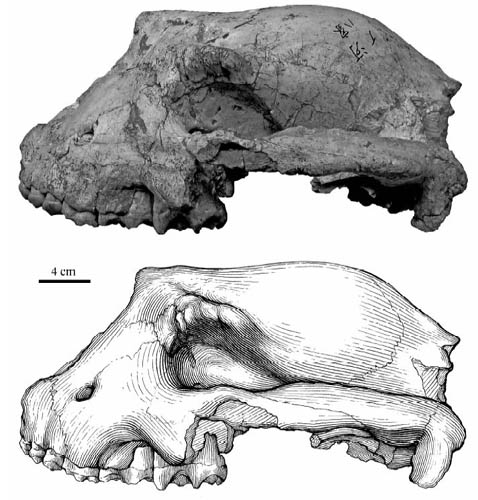| Location: Home > Research > Research Progress |
| New Chalicothere Species Found From the Late Miocene of the Linxia Basin of Gansu, China |
|
Chalicotheres were a group of extinct herbivorous, odd-toed ungulate (perissodactyl) mammals spread throughout North America, Europe, Asia, and Africa during the Early Eocene to Early Pleistocene. Fossil chalicotheres are rarely found in Chinese Neogene deposits. Dr. Deng Tao, Institute of Vertebrate Paleontology and Paleoanthropology (IVPP), Chinese Academy of Sciences, and his research team found a new chalicothere species from the early Late Miocene (Bahean or Vallesian) of the Linxia Basin of Gansu Province,China, Nestoritherium linxiaense, as reported in the latest issue of Vertebrata PalAsiatic 2012(1). This species represents the most primitive Nestoritherium known. The shortened face and quadrate brachyodont upper molars of Nestoritherium linxiaense indicate that this species should belong to Chalicotheriinae, said the first author of the study, CHEN Shaokun, a young paleontologist at the China Three Gorges Museum of Chongqing Three Gorges Institute of Paleoanthropology in Chongqing, China. The results of phylogenetic analysis shows the generic name Nestoritherium is revalidated and the subfamily Chalicotheriinae is divided into 6 genera, which are Butleria, Chalicotherium, Kalimantsia, Anisodon, Nestoritherium, and Hesperotherium. This new species Nestoritherium linxiaense is a basal species of Nestoritherium, and Hesperotherium is nested within Nestoritherium. The holotype of Nestoritherium linxiaense is a skull without the occipital surface, right zygomatic arch, premaxilla and anterior nasal bone, found from the Lower and middle part of Liushu Formation at the Houshan locality in Guanghe County, Gansu Province. The Houshan locality has yielded numerous fossil mammals, including Hezhengia bohlini, Promephitis parvus, Parataxidea sinensis, Hyaenictitherium wongii, Dinocrocuta gigantea, Tetralophodon exoletus, Hipparion chiai, H. weihoense, Acerorhinus hezhengensis, Chilotherium wimani, Iranotherium morgani, Diceros gansuensis, Cervavitus novorassiae, Metacervulus sp., Samotherium sp., Honanotherium schlosseri, Palaeotragus sp., Gazella sp., and Miotragocerus sp. The age of these fossils is thought to be the Bahean age (NMU 9), equal to the Vallesian age in Europe (MN 10). These animals are all steppe or grassland dwellers for the Northern China was dry and hot during the Late Miocene, but the find of this new chalicothere suggests a wooded and wet component. This work was supported by the National Program on Key Basic Research Project of China, Main Direction Program of Knowledge Innovation of Chinese Academy of Sciences, National Natural Science Foundation of China, and National Committee on Stratigraphy.
Fig.1 Nestoritherium linxiaense sp. nov., holotype (HMV 1432), left lateral view (Image by IVPP)
Fig.2 Nestoritherium linxiaense sp. nov., mandible (IVPP V 16376) (Image by IVPP)
|

